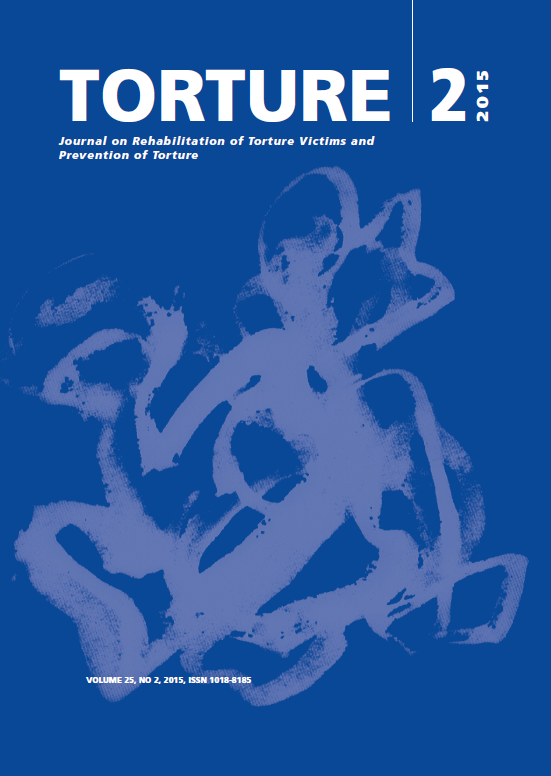Geographical distribution of torture: An epidemiological study of torture reported by asylum applicants examined at the Department of Forensic Medicine, University of Copenhagen
DOI:
https://doi.org/10.7146/torture.v25i2.109670Palabras clave:
epidemiology, medical history taking, refugees, human rights, Istanbul Protocol, forensic medicine, torture, asylum seekersResumen
Using reports from 154 examinations of alleged torture victims among asylum applicants to Denmark conducted by the Department of Forensic Medicine, University of Copenhagen, between 2001 and 2013, we have categorized the victims into four geographical regions, as well as according to the conflict that caused them to flee. The torture incidents described by the victims were divided into 12 different categories defined by the Istanbul Protocol. These data were cross-referenced in order to identify any differences in the prevalence of the 12 forms of torture. The study showed that crush injuries were only reported by refugees from Asia, including Afghanistan and Pakistan, and that incidents of electrical torture were reported twice as frequently by torture victims from Middle Eastern and North African countries, though it was lower among Iraqis, Iranians and ethnic Kurds. Sexual torture was reported by 78% of females and 25% of males.
Citas
2. Danmarks Statistik [Internet]. [cited 2012]. Available from: http://www.dst.dk
3. Masmas T, Møller E, Buhmannr C, Bunch V, Jensen J, Hansen T, et al. Asylum seekers in Denmark-a study of health status and grade of traumatization of newly arrived asylum seekers. Torture. 2008;18(2):77–86.
4. Forrest D. The physical after-effects of torture. Forensic Sci Int. Elsevier BV; 1995 Nov;76(1):77–84.
5. Hargreaves S. A body of evidence: torture among asylum seekers to the West. The Lancet. Elsevier BV; 2002 Mar;359(9308):793–4.
6. Bradley L, Tawfiq N. The physical and psychological effects of torture in Kurds seeking asylum in the United Kingdom. Torture. 2006;16(1):41-7.
7. Rasmussen O. Medical Aspects of Torture: Copenhagen University. Copenhagen. 1989.
8. Forrest D. Patterns of abuse in Sikh asylum seekers. The Lancet. Elsevier BV; 1995 Jan;345(8944):225–6.
9. Moreno A, Grodin MA. Torture and its neurological sequelae. Spinal Cord. Nature Publishing Group; 2002 May 2;40(5):213–23.
10. Leth P, Banner, J. Forensic Medical Examination of Refugees Who Claim to Have Been Tortured. Am J Forensic Med Pathol. 2005;26(2):125-30.
11. Hougen HP. Physical and psychological sequelae to torture. A controlled clinical study of exiled asylum applicants. Forensic Sci Int. Elsevier BV; 1988 Oct;39(1):5-11.
12. Edston E, Olsson C. Female victims of torture. J Forensic Leg Med. Elsevier BV; 2007 Aug;14(6):368–73.
13. Sanders J, Schuman MW, Marbella AM. The epidemiology of torture: A case series of 58 survivors of torture. Forensic Sci Int. Elsevier BV; 2009 Aug;189(1-3):e1–7.
14. Keatley E, Ashman T, Im B, Rasmussen A. Self-Reported Head Injury Among Refugee Survivors of Torture. J Head Trauma Rehabil. Ovid Technologies (Wolters Kluwer Health); 2013;28(6):E8–13.
15. Moisander PA, Edston E. Torture and its sequel—a comparison between victims from six countries. Forensic Sci Int. Elsevier BV; 2003 Nov;137(2-3):133–40.
16. Napoli AD, Baglio G, Bracci C, Taviani A, Zerbino E, Romano V. Torture survivor asylum seekers in Italy: the experience of the humanitarian association "Doctors Against Torture". Annali Di Igiene; 2005;17(4):343-50.
17. Morof DF, Sami S, Mangeni M, Blanton C, Cardozo BL, Tomczyk B. A cross-sectional survey on gender-based violence and mental health among female urban refugees and asylum seekers in Kampala, Uganda. International Journal of Gynecology & Obstetrics. Elsevier BV; 2014 Nov;127(2):138–43.
18. Poole GE, Galpin G. Prevalence of victims of torture in the health screening of quota refugees in New Zealand during 2007-2008 and implications for follow-up care. Journal of the New Zealand Medical Association. 2011;124(1338):1824.
19. Oosterhoff P, Zwanikken P, Ketting E. Sexual Torture of Men in Croatia and Other Conflict Situations: An Open Secret. Reprod Health Matters. Elsevier BV; 2004 May;12(23):68–77.
Descargas
Publicado
Cómo citar
Número
Sección
Licencia
We accept that some authors (e.g. government employees in some countries) are unable to transfer copyright. The Creative Commons Licence Attribution-NonCommercial-NoDerivatives 4.0 International (CC BY-NC-ND 4.0) covers both the Torture Journal and the IRCT web site. The publisher will not put any limitation on the personal freedom of the author to use material contained in the paper in other works which may be published, provided that acknowledgement is made to the original place of publication.


